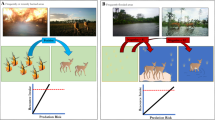Abstract.
It is well known that prey of different size and morphology often use different antipredator strategies. The prevailing notion is that this occurs because size, morphology and weaponry determine the relative effectiveness of alternative strategies, and nowhere is this assumption more entrenched than in our view of the basic decision to stay, fight or flee. Here, we use observations of coyote (Canis latrans) packs hunting deer in winter to show that two ungulates of similar size and morphology, white-tailed deer (Odocoileus virginianus) and mule deer (O. hemionus), use different antipredator strategies when encountered or attacked. Mule deer typically responded by holding their ground and aggressively defending conspecifics, and were at high risk of being attacked and killed if they fled or were undefended. White-tails always fled when pursued or attacked by coyotes. Coyotes pursued fewer white-tails than mule deer they encountered regardless of prey response. Once pursued or attacked, white-tails faced a risk of attack and capture, respectively, that was intermediate between the high and low risk mule deer groups. The overall risk of capture per encounter for white-tails was similar to that facing mule deer that confronted coyotes, which was much lower than risk facing mule deer that fled and were undefended. Contextual variables such as the opportunity to improve one's position by joining another group, moving to rugged terrain, or the presence of companions that are willing to provide defense may explain why a mixed strategy is maintained in mule deer, despite the apparently detrimental effects of flight. These examples illustrate the value of including prey behavior in models of hunting success in so far as prey defenses may not be coupled with differences in size and morphology.
Similar content being viewed by others
Author information
Authors and Affiliations
Corresponding author
Additional information
Electronic Publication
Rights and permissions
About this article
Cite this article
Lingle, S., Pellis, S. Fight or flight? Antipredator behavior and the escalation of coyote encounters with deer. Oecologia 131, 154–164 (2002). https://doi.org/10.1007/s00442-001-0858-4
Received:
Accepted:
Published:
Issue Date:
DOI: https://doi.org/10.1007/s00442-001-0858-4




